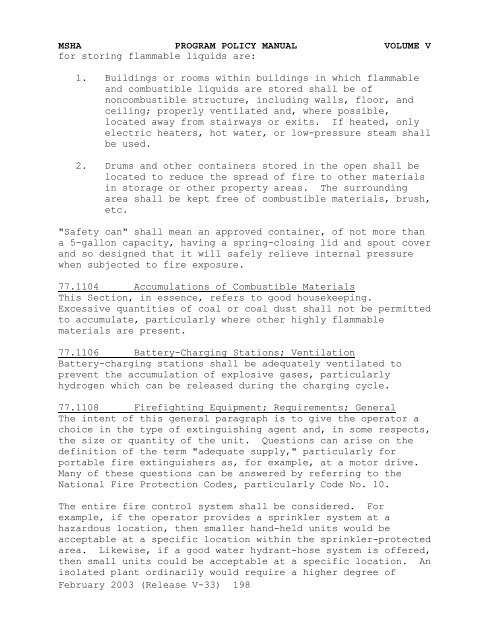Program Policy Manual - VOLUME V - Mine Safety and Health ...
Program Policy Manual - VOLUME V - Mine Safety and Health ...
Program Policy Manual - VOLUME V - Mine Safety and Health ...
Create successful ePaper yourself
Turn your PDF publications into a flip-book with our unique Google optimized e-Paper software.
MSHA PROGRAM POLICY MANUAL <strong>VOLUME</strong> V<br />
for storing flammable liquids are:<br />
1. Buildings or rooms within buildings in which flammable<br />
<strong>and</strong> combustible liquids are stored shall be of<br />
noncombustible structure, including walls, floor, <strong>and</strong><br />
ceiling; properly ventilated <strong>and</strong>, where possible,<br />
located away from stairways or exits. If heated, only<br />
electric heaters, hot water, or low-pressure steam shall<br />
be used.<br />
2. Drums <strong>and</strong> other containers stored in the open shall be<br />
located to reduce the spread of fire to other materials<br />
in storage or other property areas. The surrounding<br />
area shall be kept free of combustible materials, brush,<br />
etc.<br />
"<strong>Safety</strong> can" shall mean an approved container, of not more than<br />
a 5-gallon capacity, having a spring-closing lid <strong>and</strong> spout cover<br />
<strong>and</strong> so designed that it will safely relieve internal pressure<br />
when subjected to fire exposure.<br />
77.1104 Accumulations of Combustible Materials<br />
This Section, in essence, refers to good housekeeping.<br />
Excessive quantities of coal or coal dust shall not be permitted<br />
to accumulate, particularly where other highly flammable<br />
materials are present.<br />
77.1106 Battery-Charging Stations; Ventilation<br />
Battery-charging stations shall be adequately ventilated to<br />
prevent the accumulation of explosive gases, particularly<br />
hydrogen which can be released during the charging cycle.<br />
77.1108 Firefighting Equipment; Requirements; General<br />
The intent of this general paragraph is to give the operator a<br />
choice in the type of extinguishing agent <strong>and</strong>, in some respects,<br />
the size or quantity of the unit. Questions can arise on the<br />
definition of the term "adequate supply," particularly for<br />
portable fire extinguishers as, for example, at a motor drive.<br />
Many of these questions can be answered by referring to the<br />
National Fire Protection Codes, particularly Code No. 10.<br />
The entire fire control system shall be considered. For<br />
example, if the operator provides a sprinkler system at a<br />
hazardous location, then smaller h<strong>and</strong>-held units would be<br />
acceptable at a specific location within the sprinkler-protected<br />
area. Likewise, if a good water hydrant-hose system is offered,<br />
then small units could be acceptable at a specific location. An<br />
isolated plant ordinarily would require a higher degree of<br />
February 2003 (Release V-33) 198
















